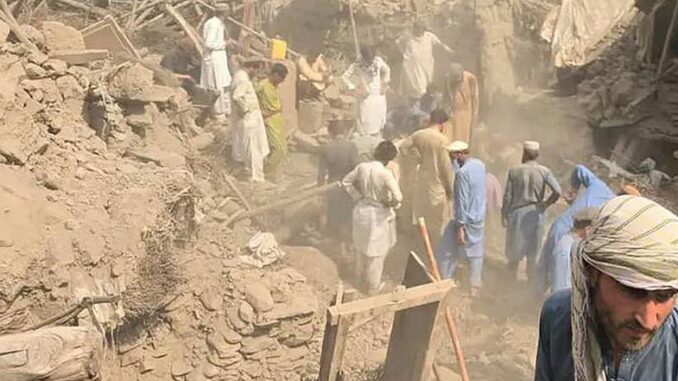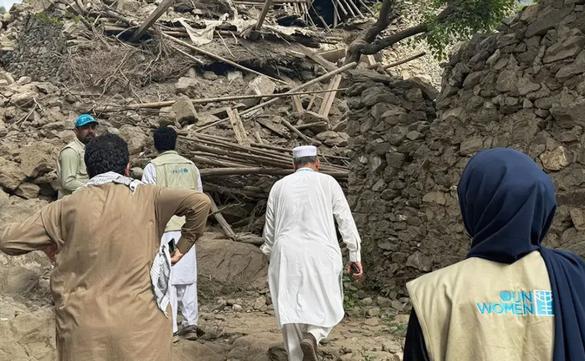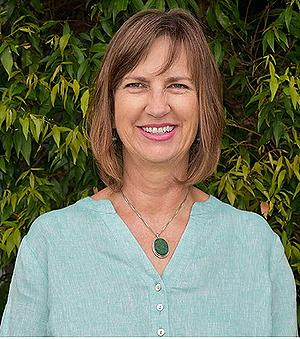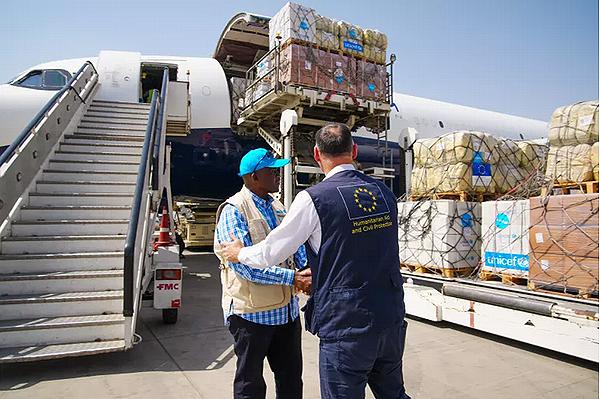
KABUL, Afghanistan, September 4, 2025 (ENS) – Preliminary reports from the frontlines of the latest Afghanistan quake now indicate that the death toll from a massive earthquake in Afghanistan last Sunday has climbed to 2,205 and the number of injured stands at 3,640 as rescue workers finally access the remote mountainous area hit by the disaster.
Hamdullah Fitrat, a spokesman for the Taliban-led government who gave the updated casualty figures in a post on X today, said that “In the earthquake-affected areas of Noor Gul District (Mazar Dara), Chawkay District (Diwa Gul Dara and Chapa Dara), and Manogai District of Kunar Province, search and rescue operations continue to recover victims from the debris of destroyed homes.”
“Rescue and relief efforts are ongoing. Tents have been installed for displaced families in multiple locations, and the organized distribution of primary and urgent humanitarian assistance is currently underway as volunteers and rescue workers negotiate treacherous terrain to reach villages where people remain trapped in the rubble,” Fitrat wrote.
Families devastated by the quake are appealing for help to find and bury the dead. Access problems are the result of rockfalls and landslides triggered by the earthquake and heavy rains in the days before the tragedy in the remote Ghazi Abad area.
The assistance mission for earthquake survivors continued Wednesday as aid teams struggled with blocked roads and downed communications lines in a bid to reach the distant communities still in need of help. Thousands of homes have been destroyed or severely damaged, leaving families without shelter and in desperate need of humanitarian assistance as winter approaches.

The latest updates from United Nations assessment teams who reached affected communities in the mountainous Ghazi Abad district on foot on Tuesday underscored the urgent need to press on with the humanitarian response.
“The issue of getting people out from under the rubble is urgent,” said Salam Al-Janabi from the UN Children’s Fund, UNICEF, in Kabul. “People are saying what is urgently needed is people to help us bury the dead and get them out.”
Casualty figures are expected to rise further as search and rescue teams reach affected areas, but some remote communities have yet to be reached.
“Our teams had to leave their cars and walk two hours to get to Ghazi Abad,” explained Al-Janabi. “Other villages are six to seven hours’ walk away and still not reached…not even by the local authorities’ helicopters.
Communications are patchy or non-existent: “There is one cell tower near a health centre, otherwise it is dark,” Al-Janabi said.
Needs of Women and Girls Could Be Ignored
On Tuesday, the agency UN Women Afghanistan issued a statement asserting that, “Afghan women and girls will be among those most affected by the devastating earthquake in eastern Afghanistan. We urge local and international responders to ensure women and girls are prioritized in the response – from urgent assistance and care to safe shelter and protection.”
In 2023 during the last major earthquake in Herat, western Afghanistan, nearly six out of every 10 of those who lost their lives were women, and nearly two-thirds of those injured also were women.

Volunteer female doctors who were near remote villages in the mountainous region and wanted to help in the immediate aftermath of the August 31 Afghanistan quake were prevented from doing so by the Taliban. Men from the villages also rejected their help.
More people are still feared trapped under the rubble. Indrika Ratwatte, the UN humanitarian coordinator in Afghanistan, said on Tuesday that even reaching the disaster was a “huge challenge.”
UN Women Afghanistan Special Representative Susan Ferguson stressed the need for Afghan women humanitarians to be part of the response.
“Women and girls will again bear the brunt of this disaster, so we must ensure their needs are at the heart of the response and recovery,” Ferguson said.

“This includes supporting the vital work of women humanitarians – otherwise women and girls could miss out on lifesaving assistance or information in the days ahead.”
More support is needed to meet the most urgent needs of women and girls, including emergency shelter; blankets and cooking sets; personal hygiene and critical medical supplies, which are reportedly running low, as well as drinking water and food.
Many Afghan women are among the first responders “working up to 18 hours a day, travelling on foot to speak directly with women and girls,” UN Women said.
“It’s exhausting work – and it’s impossible for them to reach everyone who needs help,” Ferguson explained.
The UN agency is already working in quake-affected areas with partners to assess immediate needs and prioritize emergency cash assistance and the distribution of essential items including tarpaulins, soap and feminine hygiene products.
“In a context like Afghanistan, it is essential that women are delivering assistance to women and girls,” Ferguson said. “Cultural restrictions can make it harder for women to access support and services – as we have seen with the Afghan women returnees from Iran and Pakistan.”
“Women humanitarians are vital to overcome these barriers,” she urged. “Without them, too many women and girls will miss out on lifesaving assistance.”
International Respondents Rush In
As part of the international response, the UN has dispatched at least 25 assessment teams to the affected region and boosted humanitarian air service flights from Kabul.
The UN refugee agency, UNHCR, is deploying prepositioned essential relief items such as tents, blankets and solar lamps from stockpiles in Kabul.
Immediate priority needs include emergency shelter, medical supplies, drinking water and emergency food assistance.

But “getting medicines in is very hard…They are bringing essentials only on foot” from the nearest UNICEF-supported hospital, Al-Janabi said.
Health care provision remains fragile, with medical staff at one damaged centre in Ghazi Abad with clearly visible cracks in the walls now treating people “outside, under trees,” as they are too afraid to stay inside, he explained.
Thousands of local community members are now surging into the area to help the search and rescue effort, bringing water and food with them. “People in their thousands are moving in and out of the area,” Al-Janabi said.
Shortfall Funding Crisis
While the immediate focus is on finding and helping survivors, funding shortages for humanitarian work in Afghanistan and beyond have fueled concerns that lifesaving relief work may soon be curtailed.
The UN World Food Programme, WFP, can only afford to feed earthquake victims for a few more weeks before funding runs out. This is not long enough to cater to their immediate needs nor to put them on a path to rebuilding their lives,” said John Aylieff, the agency’s top official in Kabul.
“We need donors to step in urgently and help us support families which have been devastated by this tragedy,” Aylieff said.
Of the US$2.4 billion in funding required to support aid and development programmes in Afghanistan this year, only $685.8 million has been provided by donors, according to the UN aid coordination office, OCHA.
An Active Region for Earthquakes
The magnitude 6 earthquake on August 31, 2025 occurred as the result of thrust faulting in the Hindu Kush mountains of Afghanistan, near the city of Jalalabad, according to the U.S. Geological Survey, USGS.
The earthquake occurred at a shallow depth and was the result of compressive forces driven by the northward motion of the India plate colliding with and subducting beneath the Eurasia plate.
Earthquakes are common in eastern Afghanistan and western Pakistan because of the India-Eurasia plate interactions. The USGS explains that since 1950, 71 other magnitude 6 or larger earthquakes occurred within 250 kilometers (155 miles) of the August 31 earthquake, including 6 magnitude 7 and larger earthquakes.
Featured image: Families in northeastern Afghanistan struggling to survive last Sunday’s earthquake have appealed for help to find and bury the dead. September 1, 2025 (Photo courtesy International Organization for Migration)
© 2025, Environment News Service. All rights reserved. Content may be quoted only with proper attribution and a direct link to the original article. Full reproduction is prohibited.
